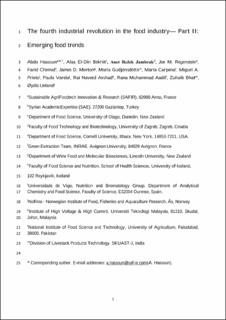The fourth industrial revolution in the food industry—part II: Emerging food trends
| dc.contributor.author | Hassoun, Abdo | |
| dc.contributor.author | Bekhit, Alaa El-Din | |
| dc.contributor.author | Jambrak, Anet Režek | |
| dc.contributor.author | Regenstein, Joe M. | |
| dc.contributor.author | Chemat, Farid | |
| dc.contributor.author | Morton, James D. | |
| dc.contributor.author | Gudjónsdóttir, María | |
| dc.contributor.author | Carpena, Maria | |
| dc.contributor.author | Prieto, Miguel A. | |
| dc.contributor.author | Varela, Paula | |
| dc.contributor.author | Arshad, Rai Naveed | |
| dc.contributor.author | Aadil, Rana Muhammad | |
| dc.contributor.author | Bhat, Zuhaib | |
| dc.contributor.author | Ueland, Øydis | |
| dc.date.accessioned | 2022-08-22T09:11:35Z | |
| dc.date.available | 2022-08-22T09:11:35Z | |
| dc.date.created | 2022-08-08T11:33:07Z | |
| dc.date.issued | 2022 | |
| dc.identifier.issn | 1040-8398 | |
| dc.identifier.uri | https://hdl.handle.net/11250/3012858 | |
| dc.description.abstract | The food industry has recently been under unprecedented pressure due to major global challenges, such as climate change, exponential increase in world population and urbanization, and the worldwide spread of new diseases and pandemics, such as the COVID-19. The fourth industrial revolution (Industry 4.0) has been gaining momentum since 2015 and has revolutionized the way in which food is produced, transported, stored, perceived, and consumed worldwide, leading to the emergence of new food trends. After reviewing Industry 4.0 technologies (e.g. artificial intelligence, smart sensors, robotics, blockchain, and the Internet of Things) in Part I of this work (Hassoun, Aït-Kaddour, et al. 2022. The fourth industrial revolution in the food industry—Part I: Industry 4.0 technologies. Critical Reviews in Food Science and Nutrition, 1–17.), this complimentary review will focus on emerging food trends (such as fortified and functional foods, additive manufacturing technologies, cultured meat, precision fermentation, and personalized food) and their connection with Industry 4.0 innovations. Implementation of new food trends has been associated with recent advances in Industry 4.0 technologies, enabling a range of new possibilities. The results show several positive food trends that reflect increased awareness of food chain actors of the food-related health and environmental impacts of food systems. Emergence of other food trends and higher consumer interest and engagement in the transition toward sustainable food development and innovative green strategies are expected in the future. | |
| dc.description.abstract | The fourth industrial revolution in the food industry—part II: Emerging food trends | |
| dc.language.iso | eng | |
| dc.subject | 3D Printing | |
| dc.subject | 3D Printing | |
| dc.subject | Consumer food behavior | |
| dc.subject | Consumer food behavior | |
| dc.subject | Food Waste | |
| dc.subject | Food Waste | |
| dc.subject | Cultured meat | |
| dc.subject | Cultured meat | |
| dc.subject | Alternative proteins | |
| dc.subject | Alternative proteins | |
| dc.title | The fourth industrial revolution in the food industry—part II: Emerging food trends | |
| dc.title.alternative | The fourth industrial revolution in the food industry—part II: Emerging food trends | |
| dc.type | Peer reviewed | |
| dc.type | Journal article | |
| dc.description.version | submittedVersion | |
| dc.source.journal | Critical reviews in food science and nutrition | |
| dc.identifier.doi | 10.1080/10408398.2022.2106472 | |
| dc.identifier.cristin | 2041669 | |
| dc.relation.project | Nofima AS: 202103 | |
| dc.relation.project | Norges forskningsråd: 314318 | |
| dc.relation.project | EC/H2020/888003 | |
| cristin.ispublished | true | |
| cristin.fulltext | preprint | |
| cristin.qualitycode | 1 |
Tilhørende fil(er)
Denne innførselen finnes i følgende samling(er)
-
Artikler / Articles [1456]
-
Publikasjoner fra CRIStin [2533]
